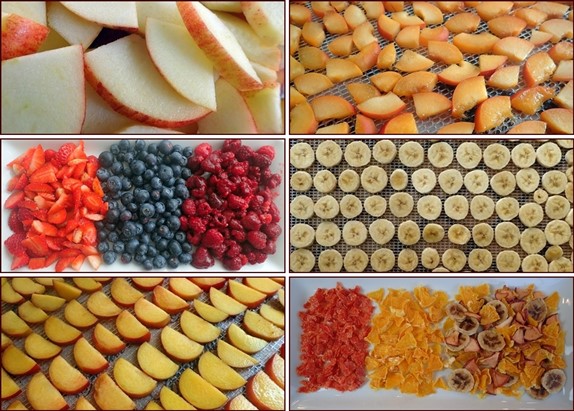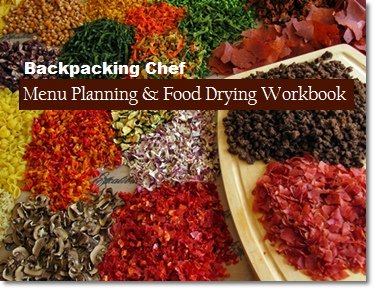Dehydrating Fruit Guide
A Comprehensive & Fun Guide to Dehydrating Fruit for Backpacking & Home Storage.
Topics Covered:
- How to dehydrate fruit safely and efficiently.
- Instructions for dehydrating fruit from A to Z.
- Recipes for dehydrated fruit cocktails, fruit trail mixes, fruit leathers, and fruit smoothies.
Dehydrating fruit reduces pounds of juicy goodness into ounces. One average-size apple weighs about eight ounces, but after dehydrating it, the apple weighs only one ounce. The calories, fiber, flavor, minerals, antioxidants, and vitamins are all concentrated, so you get maximum nutrition for minimum weight. Vitamin C content is partially reduced when dehydrating fruit due to the heat, but this can be offset somewhat by dipping certain fruits in lemon juice or a solution of ascorbic acid and water.
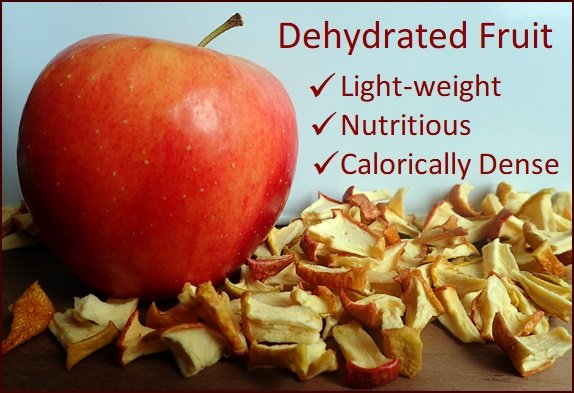
Benefits of dehydrating fruit: Light-weight, nutritious, colorically dense, and delicious!
Dehydrating Fruit from A–Z:
Apples, Apricots, Bananas, Berries, Cantaloupe, Cherries, Grapes, Kiwi, Lemons & Limes, Mangoes, Nectarines, Oranges, Peaches, Pears, Pineapples, Strawberries, and Watermelon.
Instructions for Dehydrating Fruit
Choose mature, firm fruits for the highest sugar and nutritional content. Avoid bruised or overripe fruit.
Rinse fruit before cutting to remove dirt and pesticides. Dehydrating fruit with the skin on retains more nutrition in the dried fruit, especially the beneficial flavonoids.
Cut apples, apricots, bananas, mangos, peaches, pears, and strawberries into slices about ⅛-inch to ¼-inch thick.
Pretreating Fruit before Dehydrating
The flesh of apples and pears may brown slightly after cutting and dehydrating. This is called oxidation, which does not affect the taste or nutrition of the fruit in the short term.
To minimize oxidation, place fruit, as soon as you cut it, into a bowl with lemon juice, or in a solution of ascorbic acid (vitamin C) and water for ten minutes.
Lemon Juice Pretreatment: The citric acid in lemon juice works as an antioxidant. If you use lemon juice full-strength, the lemon flavor will transfer to the apples and pears, which can be nice, especially with grated apples. For a less intense transfer of lemon flavor, dilute the juice with an equal or greater amount of cold water. Stir the cut fruit around in the lemon juice to coat each piece.
Ascorbic Acid Pretreatment: Dissolve 2½ tablespoons (34 g) of pure ascorbic acid crystals in 1 quart or liter of cold water. If using crushed vitamin C tablets (500 mg), use about 48 tablets for a liter of water. Soak fruit for ten minutes. Source: Colorado State University Extension, Dehydrating Fruit.
Dehydrating Fruit
The recommended temperature for dehydrating fruit is 135°F (57°C), with the exception of lemons and limes, which turn brown unless dried at the lower temperature of 115°F (46°C).
Spread sliced fruit in a single layer on dehydrator trays. It is much faster to dehydrate fruit on mesh dehydrator trays, rather than dehydrating fruit on nonstick sheets. Excalibur dehydrators have flexible mesh sheets, which make it easy to pop off dried fruits that may become sticky while drying, like sliced grapes and overripe bananas.
Cut blueberries, cherries, and grapes into halves or quarters. Grapes can even be sliced. Although time-consuming on the front end, cutting these fruits and berries through their waxy skins will open the insides to evaporation, and will substantially reduce the time it takes to dehydrate them. Another method of “cracking” the skins of these fruits is to dip them in boiling water for 30 seconds, followed by plunging them into ice-cold water. Backpacking Chef finds that this method isn’t 100% effective, that it likely causes destruction of some vitamins, and that dehydration takes much longer than if these fruits and berries are cut or sliced.
Most dehydrated fruit will be pliable or leathery when done, meaning you can bend it and tear it, but it won’t be so dry that you can snap it.
The range of drying times listed below for dehydrating fruit are what you could expect using an Excalibur Food Dehydrator. Factors such as dehydrator model, humidity, thickness of your fruit pieces, amount of fruit in the dehydrator, and juiciness all affect how long it takes fruit to dry.
When shopping for a food dehydrator, make sure it has a fan and temperature controls. Otherwise, you may grow a beard waiting for the fruit to dry. I use Excalibur Dehydrators for dehydrating fruit because the large square trays hold more fruit than round dehydrators with holes in the middle. Read my comparison of Excalibur and Cosori dehydrators to Nesco dehydrators.
Conditioning Dehydrated Fruit
After dehydrating fruit, place it loosely in a glass or plastic container with a lid. Conditioning allows any moisture that may have been present in thicker pieces of fruit to migrate into drier pieces of fruit. Shake the container once a day for a week. If any moisture forms on the inside of the container, put the fruit back in the dehydrator and dry it longer. The risk of dehydrating fruit insufficiently is that mold can grow. So make sure it’s dry!
Packing & Storing Dehydrated Fruit
Over time, oxidation will diminish the vitamin content and flavor of fruit. Vacuum sealing or using oxygen absorbers will limit the rate of oxidation if you need to store dried fruits for longer than a few months.
Mason Jars: Store dehydrated fruit at home in glass containers with tight-fitting lids, such as Kerr or Ball mason jars. Use the smallest-size jar possible to accommodate the dried fruit, as that will minimize the amount of oxygen in the container. For storage longer than a few months, add a 100cc oxygen absorber to the jar.
Vacuum-Seal Bags: Another way to pack and store dried fruit at home is to pack ½-cup portions in snack-size Ziploc bags. Place a tiny slip of paper across each zip closure to allow air to escape during vacuum-sealing. Place several individually packed servings of fruit inside a larger vacuum-seal bag, insert a 100cc oxygen absorber to mop up any residual oxygen, and vacuum seal the bag. Mylar storage bags may also be used.
On the Trail: I pack individual servings of dried fruit, usually half-a-cup each, in snack-size Ziploc bags. While backpacking, I eat one or two servings of dried fruit per day. I vacuum seal my daily rations, so one or two servings of dried fruit go into the same bag as breakfast, lunch, and dinner.
Dehydrating Fruit from A–Z
Dehydrating Apples
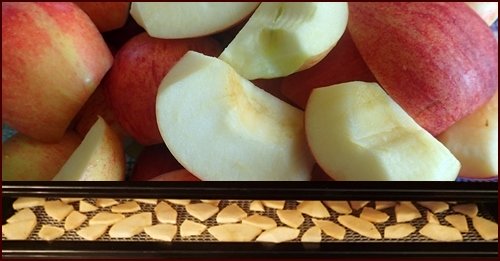
Quarter the apples from top to bottom, and cut out the core and stem. Slice the quarters crosswise into ⅛-inch to ¼-inch thick pieces.
Dehydrate apples at 135°F (57°C) for 8–12 hours until pliable.
Apples will start to turn slightly brown within minutes of cutting and exposing the flesh to air in a process called oxidation. If you get your apples in the dehydrator right away, the color change will be minimal, and vitamin content and taste will be well preserved. Pears, peaches, and apricots also undergo some oxidation after the flesh is exposed to oxygen.
To reduce oxidation, pretreat apples using the lemon juice or ascorbic acid solutions previously described.
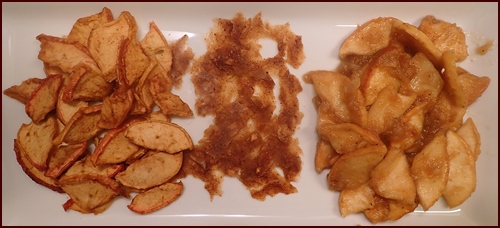
Explore More...
Dehydrating Apple Projects: Dehydrating grated apples, baked apples, stove-cooked apples, and applesauce. Recipes for Tortilla Apple Tarts, Apple-Berry Muesli, and Pumpkin Spice Apples.
Dehydrating Apricots
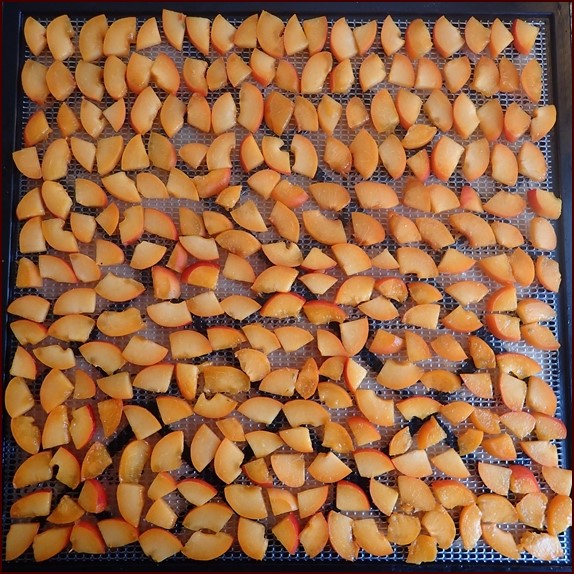
Wash apricots, cut in half, remove pits, and slice each half into four pieces lengthwise. Then slice each of those pieces crosswise four times.
Spread apricot pieces in a single layer on mesh dehydrator sheets.
Dehydrate apricots at 135°F (57°C) for approximately 11 hours until flat, pliable, and almost snappy.
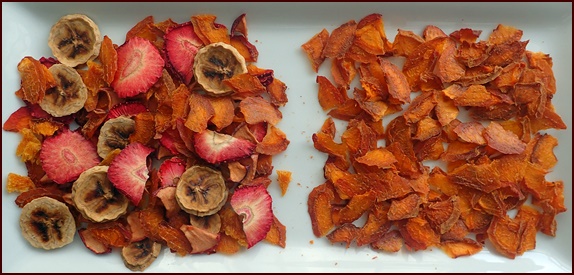
Photo above: dried apricots on right; and in a fruit cocktail mix on left.
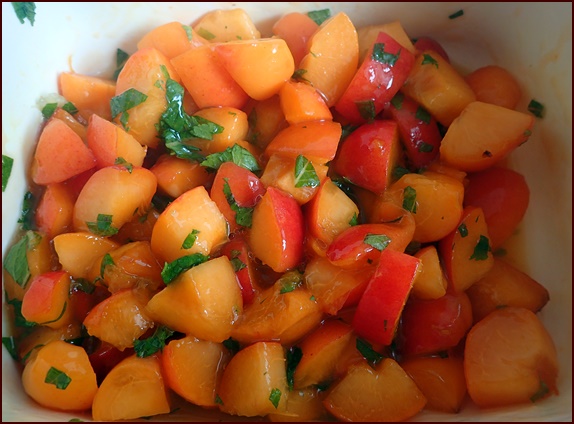
Photo: Ingredients for apricot-mint-salsa.
Explore More...
Dehydrating Apricots Projects: Preparing apricots for drying, Apricot Fruit Leather Recipes, Apricot Fruit Leather Pudding, Apricot-Mint Salsa, Cold-Soak Apricot Salsa Rice Salad.
Dehydrating Bananas
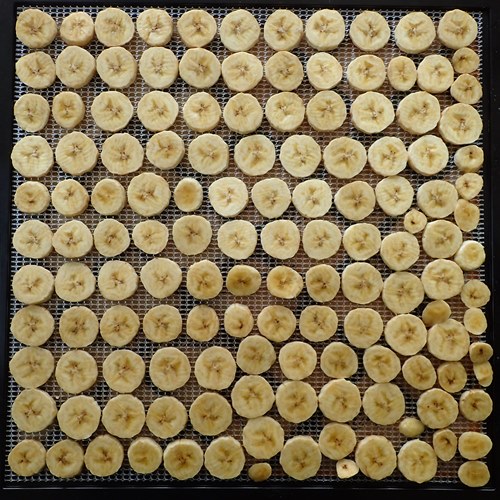
Choose bananas with some brown speckles on the peel for maximum sweetness, but avoid drying over-ripe, soft bananas.
Peel the bananas and slice crosswise into ⅛-inch to ¼-inch thick pieces. If desired, dip the banana slices in lemon juice before drying.
Dehydrate bananas at 135°F (57°C) until chip-like or leathery, approximately 8–12 hours.
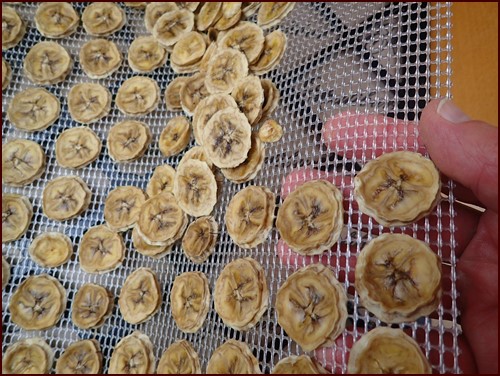
Dried bananas can be difficult to remove from hard plastic dehydrator trays. Using flexible poly-screen tray inserts, such as those that come standard with Excalibur dehydrators, makes it much easier to pop the dried bananas right off.
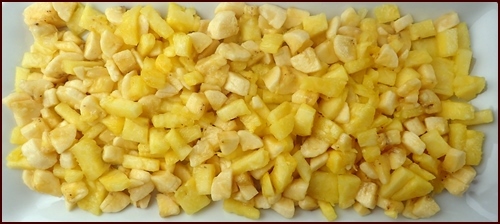
Photo: Ingredients for banana-pineapple fruit leather.
Explore More...
Dehydrating Bananas Projects: Banana Fruit Leather, Banana-Pineapple Pudding, Banana Split Pudding, Banana Pudding with Chocolate & Nuts, Banana Nut Bread Pudding, and Grahma Nanna Nilla Pudding.
Dehydrating Berries
Dehydrating Blueberries
Blueberries are only fair for snacking on plain. They are tasty in oatmeal, muesli, trail mixes, and as a topping for dried angel food cake when rehydrated and warmed. They can also be blended with other fruits into fruit leather.
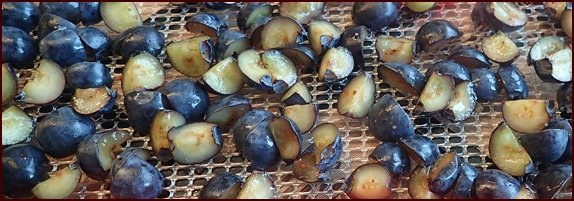
Wash blueberries and remove the stems.
Blueberries will dry faster and turn out crispier if you cut the berries in half, or even quarters, as shown above. An alternative to cutting the blueberries is to break the skins using the checking method: Place blueberries in a colander and dip in boiling water for 30 seconds and then in cold water to check (break) the skins. Blueberries will take much longer to dry with the checking method.
Place the blueberries in a single layer on the dehydrator tray.
Dehydrate blueberries at 135°F (57°C) until leathery, approximately 14–16 hours.
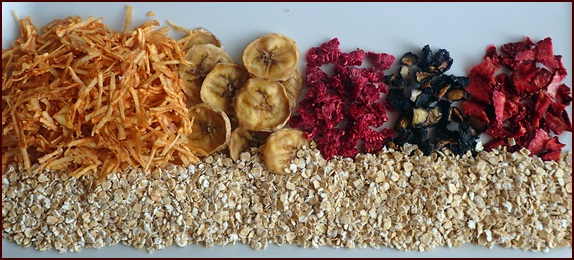
Photo: Dehydrated grated apples, bananas, raspberries, blueberries, and strawberries. Excellent in Bircher Muesli.
Blueberries are good in fruit leathers, and they can also be dried and ground into fruit powder.
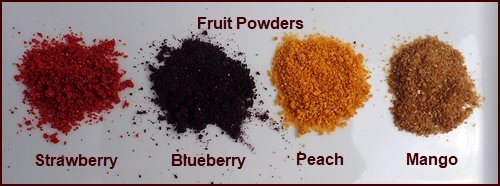
Explore More...
Dehydrating Fruit Leather and Fruit Powder.
Dehydrating Raspberries & Blackberries
Like blueberries, raspberries and blackberries are only fair for snacking on by themselves, but they add nice color and nutrition to trail mixes, fruit cocktails, and oatmeal. They are also excellent blended into fruit leather. One downside of dehydrating raspberries and blackberries is that you end up with a lot of seeds. Each berry is made up of around 100 drupelets with a seed inside each one.
Raspberries are small enough to cut in half for drying. Dehydration will go much faster than if the berries are dried whole. Small blackberries can also be cut in half, but for large blackberries, slice them crosswise into ¼-inch slices, as shown below.
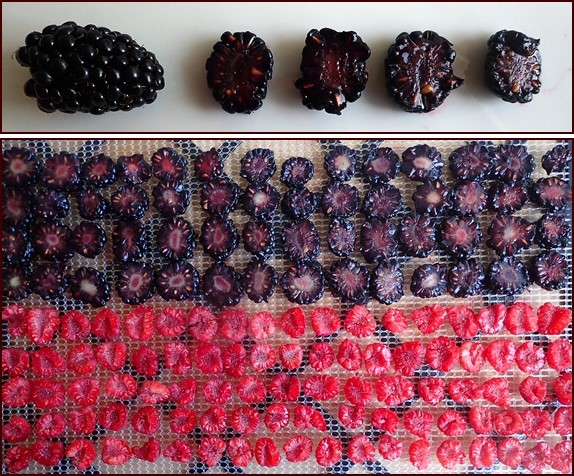
Dehydrate raspberries and blackberries directly on mesh sheets at 135°F (57°C). Small raspberries, cut in half, will dry in approximately 10–12 hours. Larger blackberries may take 14–16 hours.
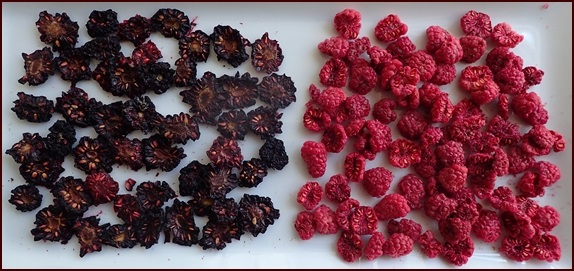
Photo: Dehydrated blackberries and raspberries.
Dehydrating Strawberries
Dried strawberries are only fair for snacking on plain, but they are delicious in trail mixes, fruit cocktails, fruit leathers, or when rehydrated and heated with chocolate sauce in Trail Angel Cake.
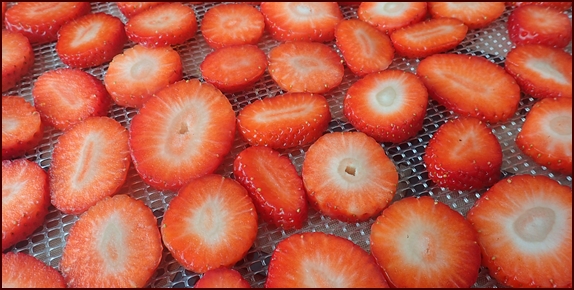
Wash strawberries and pat dry with paper towels, or wash and spin them in a salad spinner. Cut off the leafy crown and slice strawberries crosswise into ¼-inch thick pieces.
If you want to sweeten the strawberries, sprinkle with sugar after you place the slices on the trays. Sweetening the strawberries in a bowl first draws out juices and makes them messier to work with.
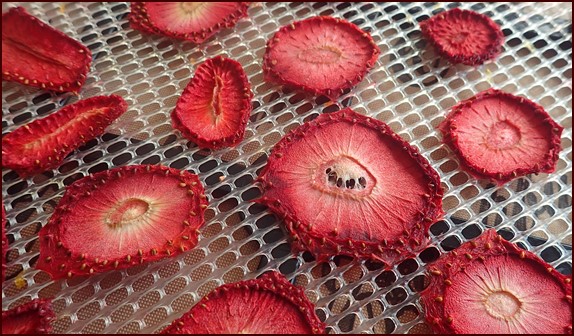
Dehydrate strawberries at 135°F (57°C) for approximately 6–8 hours. Dried strawberry slices will be very thin and will break in half when you test them for dryness.
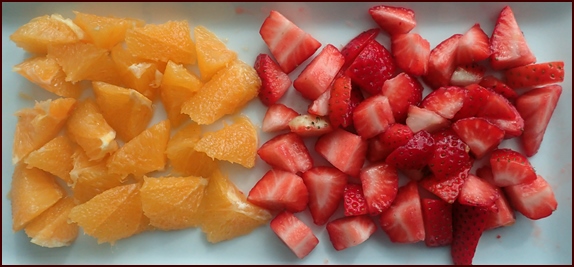
Photo: Ingredients for strawberry-orange fruit leather.
Explore More...
Dehydrating Strawberries Projects:
More about dehydrating strawberries, strawberry powder, strawberry
tortillas with chocolate or peanut butter, and strawberry trail angel
cake.
Strawberry Fruit Leather: How to make it, several recipes, how to pack it, and how to make delicious puddings and snacks with strawberry fruit leather.
Dehydrating Cantaloupe
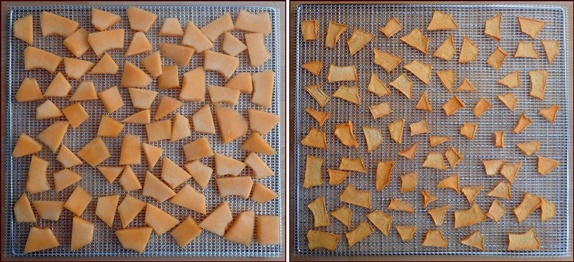
Cut cantaloupe in half longwise, remove seeds, and then cut each half into ¼-inch thick slices.
Trim away the rind and cut flesh into pieces or strips.
Dehydrate cantaloupe at 135°F (57°C) for approximately 8–10 hours until no moisture is present when you tear a piece in half. Dried cantaloupe will be pliable.
Explore More...
Guide to Dehydrating Cantaloupe & Cantaloupe Fruit Leather
Dehydrating Cherries
Dried cherries are sweet and chewy. High in Vitamin C and great for snacking, they are also delicious in trail mixes, fruit cocktails, and any trail dessert with chocolate.
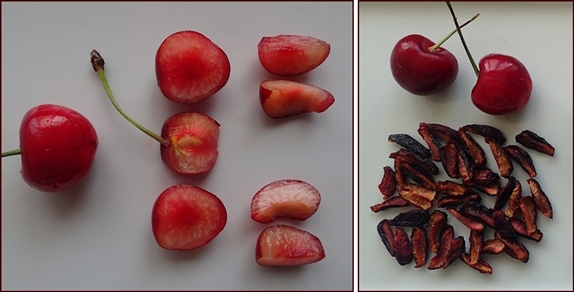
The photo above shows recommended method to cut cherries for drying. They dry evenly and faster when quartered than when dried in halves. Bottom right: Quartered cherries after drying.
Run a sharp knife from top to bottom around the cherry. Then turn the cherry 90° and make another cut from top to bottom. Pull apart the quarters and remove the pit.
Spread quartered cherries in a single layer directly on mesh sheet of dehydrator.
Dehydrate cherries at 135°F (57°C) for approximately 14–16 hours.
Dehydrating Grapes
Grapes are very sweet when dried. They are delicious in trail mix and rehydrated fruit cocktail.
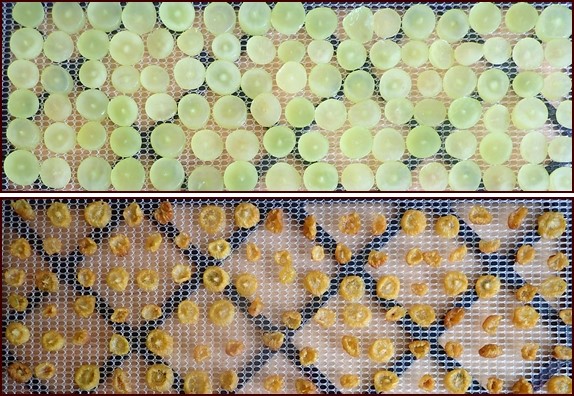
Photo: Dehydrating sliced grapes, before and after.
Tip: Use seedless grapes.
Slice grapes crosswise three times, or they will take much longer to dry if only cut in half. They stick to mesh sheets a little, but once sufficiently dry, they come off without too much effort.
Dehydrate grapes at 135°F (57°C) for 18–20 hours, or longer if necessary. They will be pliable and a little sticky. Green grapes will turn golden yellow. Purple grapes will turn darker purple with green insides.
Store dehydrated grapes in an airtight container after conditioning.
Dehydrating Kiwi
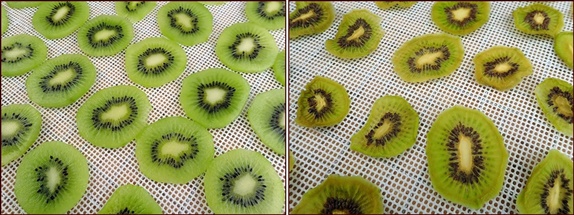
Cut kiwis crosswise into thin slices and arrange in a single layer on a nonstick mesh dehydrator sheet.
Dehydrate kiwi at 135°F (57°C) for 10+ hours until no moisture appears when you tear pieces in half.
Dehydrated kiwi fruit will be pliable, slices will mostly bend and not break.
Explore More…
Dehydrating Kiwi & Kiwi Fruit Leather
Dehydrating Lemons & Limes
While oranges dry perfectly fine at 135°F (57°C), lemons and limes will turn brown at that temperature.
The best way to dehydrate lemons and limes is to turn down the temperature and shorten the drying time with strategic slicing and drying.
Step One: Wash the fruit.
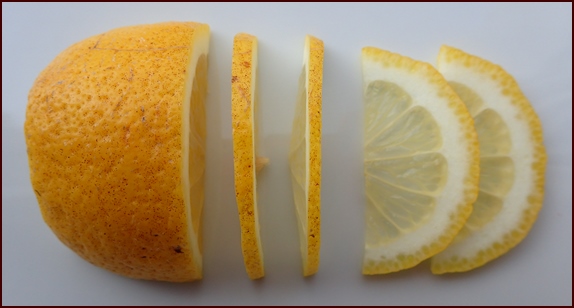
Step Two: Slice the fruit in half longwise. Place lemons cut-side down, and cut crosswise into ⅛-inch thick slices. A very sharp chef’s knife is the best tool to cut thin slices without expelling much juice.
Step Three: Place lemon / lime slices on dehydrator tray covered with a nonstick sheet. Position slices with the cut side facing into the direction of the airflow.
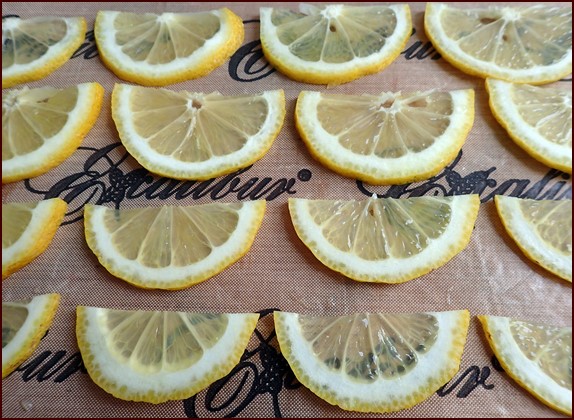
Step Four: Dehydrate lemons and limes at 115°F (46°C). Time setting: 12 hours.
Step Five: After about an hour, there should be no loose juice around the lemon slices. Transfer the lemon slices to a mesh tray without a nonstick sheet. Continue drying until rinds are crispy and no moisture remains in fruit, approximately 12–14 hours.
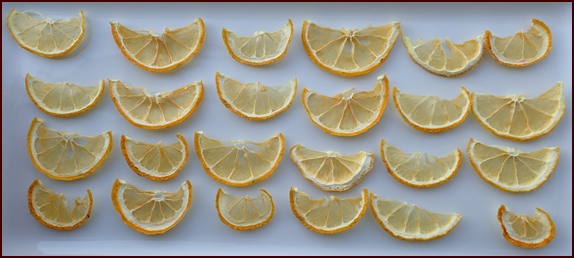
Notes:
Slicing lemons and limes into half-round slices, rather than full-round slices; and positioning the fruit so that the cut side faces the airflow, reduces the amount of time it takes to dry the fruit.
Since the rinds and interior walls do not shrink as much as the fruit during dehydration, the ⅛-inch thin slices are more attractive when dried than thicker-cut slices.
Dried lemon and lime half-slices are delicious! The rinds are crunchy, and the fruit lets go a burst of citrusy zing. Take your time chewing them for the full effect. Include dried lemons and limes in trail mixes, fruit cocktails, and trail desserts. Add a few slices to your water bottle for flavor and a vitamin C boost.
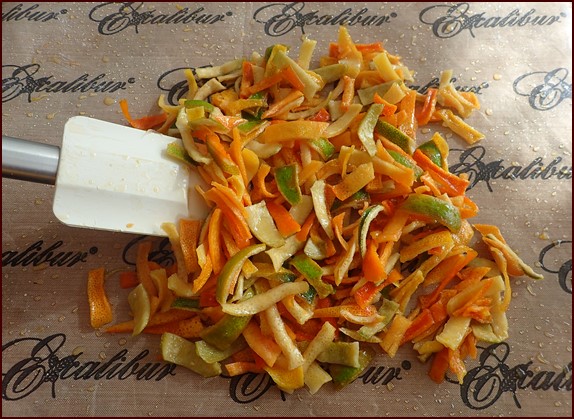
Explore More…
Dehydrating Fruit Project: Candied Citrus Peels.
Dehydrating Mangoes

Photos: A mango with two lines showing where to make the first two cuts to the left and right of the pit. The pit is hiding in the piece on the far right.
Orient the mango long ways with the narrow profile of the mango facing you. Make two cuts all the way down the mango about a quarter inch from center left and right. You may bump into the pit, so just keep sliding the knife along the pit.
Cut the flesh off the pit in the center section as best you can into ⅛-inch to ¼-inch thick pieces. Lay the two outer sections flat-side down and cut in half lengthwise. Cut off the skin, and then slice the quarters crosswise into ⅛-inch to ¼-inch thick pieces. Spread in a single layer on the dehydrator trays
Dehydrate mangoes at 135°F (57°C) until pliable, approximately 8–12 hours.
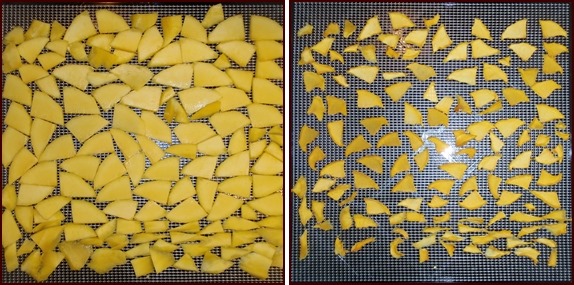
Photos: Dehydrating mango, before and after.
Explore More...
Dehydrating Mango Projects. How to select ripe mangoes for drying and learn different ways to cut them. Recipes for Dehydrated Mango Fruit Cocktail, Mango Salsa, and Mango Salsa Salad with Rice or Couscous.
How to Dehydrate Mango Fruit Leather, and how to use it to make smoothies and puddings on the trail. Lot's of great recipes.
Dehydrating Nectarines
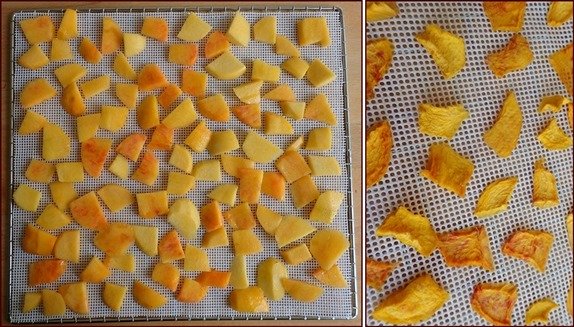
Nectarines may be dried with or without the peels.
Cut nectarines into uniformly-thick slices between ⅛-inch and ¼-inch thick.
With a freestone nectarine, cut the nectarine downward from the stem into four quarters, then cut each quarter crosswise into slices of equal thickness.
With a clingstone nectarine, cut slices downward starting from the outside of the nectarine until you reach the pit. Then rotate the nectarine in quarter-turns, slicing from the outside to the pit.
Dehydrate nectarines at 135°F (57°C) for approximately eight hours. Dried nectarines will be pliable with no moisture appearing when you tear a few pieces in half.
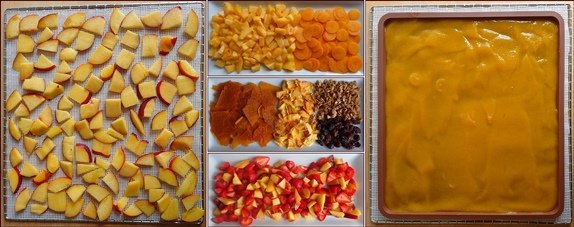
Explore More…
Guide to Dehydrating Nectarines & Nectarine Fruit Leather.
Dehydrating Oranges
There are many ways to cut and dehydrate oranges for use on the trail.
If dehydrating oranges in slices, cut them as thinly as possible and place the slices on top of nonstick sheets in the dehydrator. The thinner you slice them, the faster they will dry. One Excalibur Dehydrator tray will accommodate four to five sliced oranges.
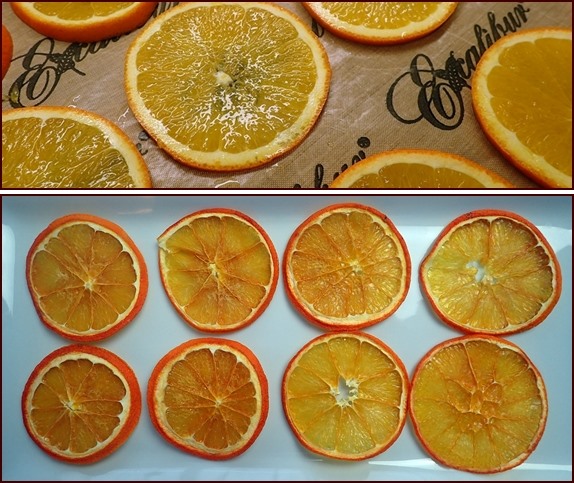
Dehydrate oranges at 135°F (57°C). The dehydrated orange slices shown in the photo above were dry in 14 hours.
Fully dried orange slices will bend or snap in half. The peels will be crunchy.

Explore More...
Dehydrating Oranges Projects: Dehydrating orange pieces, orange fruit leather, orange juice powder, and candied citrus peels.
Dehydrating Peaches
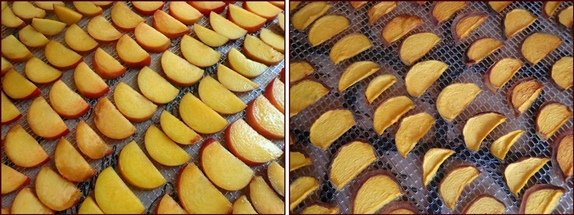
Firm peaches are easier to process and will dry faster than soft peaches. However, peaches that are very firm may lack sweetness because they are not ripe. Look for peaches that have good color and a little give when you squeeze them. If desired, remove the skins with a sharp peeler.
Cut the peaches in half or quarters and remove the pits and the fibrous red parts around the pits. Then slice the halves or quarters crosswise into ⅛-inch thick pieces. It’s easier to remove the pits of clingstone peaches if you cut the peaches into quarters, since the pits adhere to the flesh of the fruit. The pits of freestone peaches pop out easily.
Dehydrate peaches at 135°F (57°C) until pliable, approximately 8–12 hours.
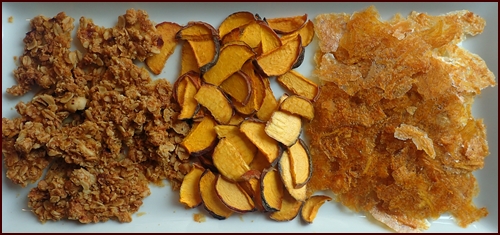
Explore More...
Dehydrating Peaches Projects: More about dehydrating peaches, recipes for Peach Leather, Peach Granola Clusters, Peach Perfect Trail Mix, Hot Peach Crumble, Peach Crunch Breakfast, and Peachy Fruit Cocktail.
Dehydrating Pears
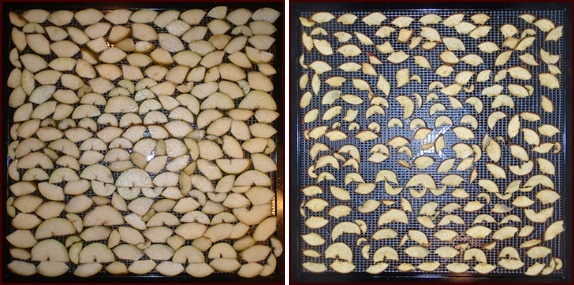
Photo: Dehydrating pears, before and after. Shown with skin on.
Dried pears are very sweet and melt in your mouth.
Wait until pears have ripened, but not softened too much before drying. Peel if desired. Cut the pears in half lengthwise. With a knife, trace the fibrous line leading from the stem down to the pit and make a shallow cut. Pull the fibrous part out. Slice the narrow part of the pear crosswise into ⅛-inch thick pieces. Cut the wide part of the pears lengthwise again and cut out the core. Slice the quarters crosswise into ⅛-inch thick pieces.
Dehydrate pears at 135°F (57°C) until pliable, approximately 8–12 hours.
Explore More…
Dehydrating Pears & Pear Fruit Leather | 6 Ways
Sliced, chocolate covered, cooked, sweetened skins, pear fruit leather recipes & Blueberry-Crunch Pear Sauce Dessert!
Dehydrating Pineapple
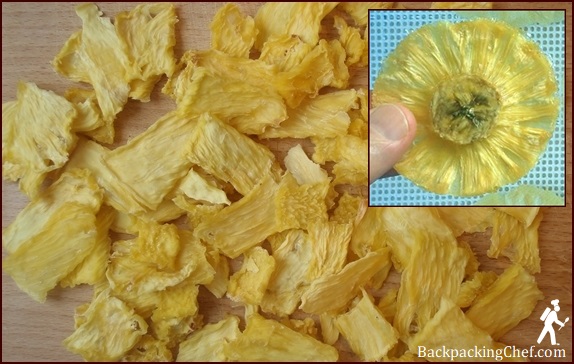
Dehydrate pineapple at 135°F (57°C) until pliable. It can take from 10–18 hours, depending on whether you are drying thin slices or thicker pineapple rings. Other factors that affect drying times are how many trays of pineapple are being dried, and how juicy the pineapple is to begin with.
You can dehydrate canned pineapple easily by simply placing the pineapple rings or chunks on dehydrator trays. Drying goes faster if you use silicone mesh sheets instead of solid nonstick sheets.
To dehydrate thin slices using fresh pineapple, cut the pineapple crosswise into ¾-inch to 1-inch thick rings. Remove the fibrous skin of the pineapple rings. Then slice the rings crosswise into thinner ⅛-inch thick pieces, discarding the fibrous core.
Explore More…
Dehydrating Pineapple: Fresh, Canned & Delicious.
Article covers: How to dehydrate fresh pineapple and canned pineapple. Selecting a ripe pineapple. Preparing pineapple for dehydration. Methods for dehydrating not-so-ripe pineapples. Storing dehydrated pineapple. Delicious ways to use dried pineapple in trail mixes, fruit cocktails, smoothies, meals, and desserts.
Dehydrating
Watermelon
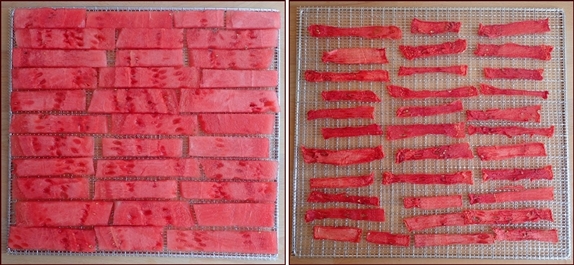
Place watermelon strips directly on mesh dehydrator sheets.
Dehydrate watermelon at 135°F (57°C) for approximately 11–12 hours.
Dehydrated watermelon with be pliable and slightly tacky due to the high concentration of natural sugar.
Explore More…
Guide to Dehydrating Watermelon & Watermelon Fruit Leather
Fruit Cocktail
Hot Fruit Cocktail
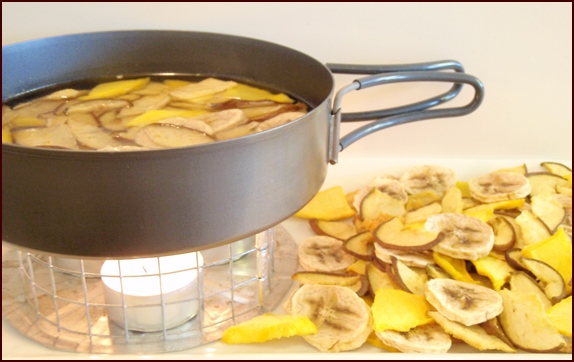
Combine one cup of any combination of dried fruit with one cup water. Soak for ten minutes and then heat slowly for ten more minutes. Try ½ cup dried pears, ¼ cup dried bananas, ⅛ cup dried pineapple, and ⅛ cup dried mango or peaches. Apples and berries are a nice combination too.
Serving suggestions: Top heated fruit cocktail with extra goodies like granola, nuts, crumbled oatmeal cookies, or dried cake.
Cold Fruit Cocktail
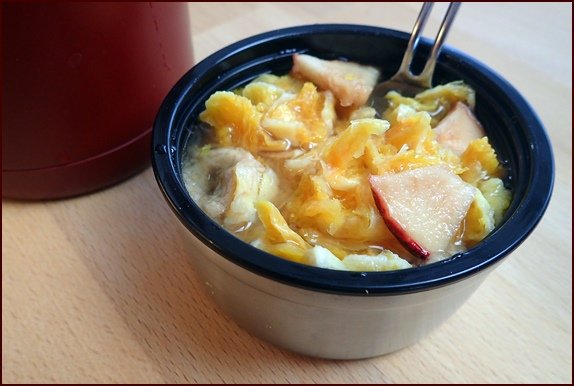
To make a juicy fruit cocktail, combine one cup of dried mixed fruit with two cups of cold water in a Thermos Food Jar or other container with a good lid. The result will be one cup of refreshing fruit juice and a tasty serving of rehydrated fruit. Add a teaspoon of sugar to the fruit cocktail if desired.
See my page about backpacking with a thermos food jar.
Disclosure: As an Amazon Associate, Backpacking Chef earns from qualifying purchases. Thank you.
Dehydrating Fruit Leather
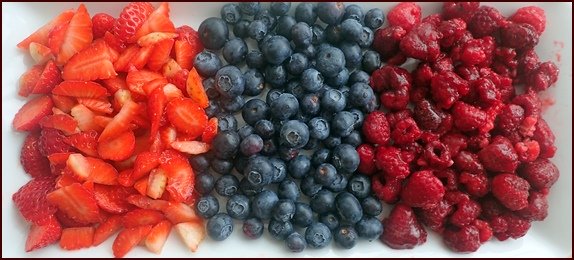
Mixed Berry Fruit Leather
Ingredients: 1¼ cups mixed berries (260 g), 2 Tbsp. cranberry juice, and ½ Tbsp. fine sugar.
Quantities are flexible when you make fruit leather. For most dehydrators, you want to cut up enough fruit to produce 1–1¼ cups of blended fruit per dehydrator tray. You may add a little fruit juice to the blender to achieve a smooth consistency. If you prefer, substitute honey or a tiny pinch of stevia in place of sugar, or leave out the sweeteners entirely.
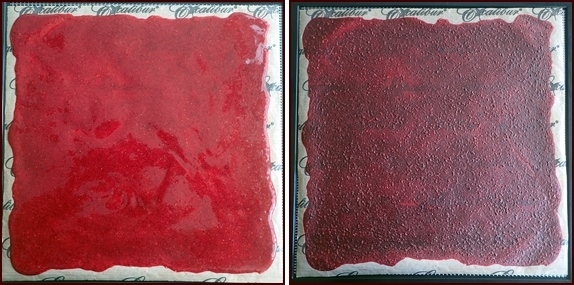
Photo: Dehydrating fruit leather, before and after.
Run the ingredients through a blender and spread 1–1¼ cups of blended fruit on dehydrator trays covered with nonstick sheets.
Dehydrate fruit leather at 135°F (57°C) for 6–8 hours.
The easy way to separate dried fruit leather from a nonstick sheet is to flip the leather over and peel away the nonstick sheet. If the fruit leather is slightly moist on the bottom, continue drying it directly on the mesh dehydrator trays.
Packing Fruit Leather:
Fruit leather tends to stick to itself if your tear it into pieces for packing. The pressure of vacuum sealing makes it stick even worse. Folding up the fruit leather in baking paper (parchment paper) solves the problem.
Cut a piece of baking paper about three inches wider than the fruit leather as shown in the photo below.
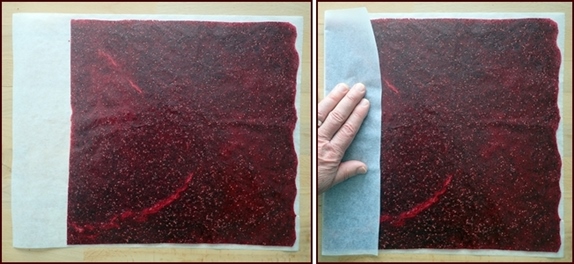
Fold the extra paper over first, then continue folding the leather so you end up with four columns folded into one. Then fold in half the other way. You can fit several folded fruit leathers in one quart-size Ziploc bag. For long-term storage, consider using 8-inch wide vacuum seal bags to preserve several leathers.
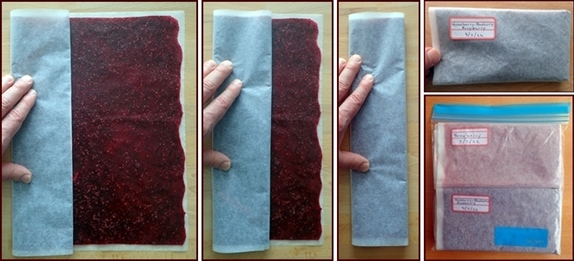
Fruit Leather Pudding
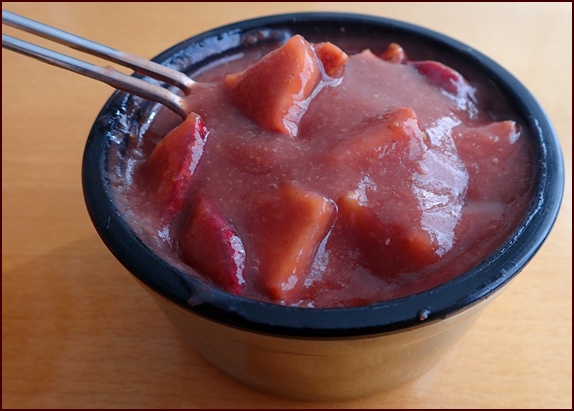
Servings: 1
Ingredients:
- 1 sheet of mixed-berry fruit leather (30 g)
- ¼ cup dried apples or pears (15 g)
- ¾ cup water to rehydrate
On the Trail:
Add dried apples to water in a pot and soak five minutes. Light stove. When a boil is reached, turn off the stove and stir in the fruit leather, which will dissolve quickly. Wait a few minutes to serve. The fruit leather pudding may be rehydrated with cold water with a little more soak time and more spirited stirring.
Explore More...
Dehydrating Fruit Projects:
Apples, Apricots, Bananas, Cantaloupe, Kiwis, Mangoes, Oranges, Peaches, Pears, Strawberries, and Watermelon.
Dehydrating Fruit Leather (50+ Fruit Leather Recipes)
Fruity Backpacking Dessert Recipes.
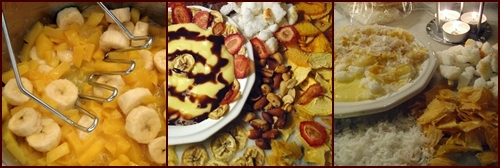
Dehydrating Fruit Projects in
Recipes for Adventure II: The Best of Trail Bytes
View Table of Contents of Recipes for Adventure II.

Share this page with friends on social media.
Free E-book & Newsletter
Free with Trail Bytes subscription.
Dehydrating Food from A–Z

